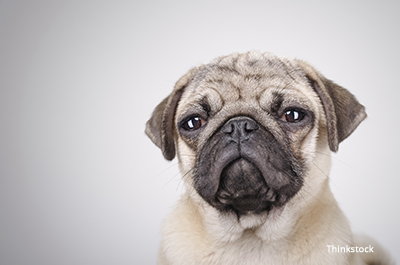
Zee Mahmood, a veterinary technician in Reading, PA, contributed to this article.
Several conditions of the eye are painful or can lead to blindness. Although our goal is to try everything to save a dog’s eye, sometimes, sacrificing the eye is the best or the only solution. The surgical removal of an eyeball is called enucleation. Despite how horrifying it may sound, it is a fairly common procedure that dogs adapt to very well. Please be aware, the information below is not for the faint of heart…
When is enucleation needed?
Reasons for enucleation include severe trauma (e.g. a puncture or perforation of the eyeball) and conditions in or around the eye (e.g. cancer or glaucoma).
Brachycephalic dogs (who have a flat face and prominent eyes, such as bulldogs and pugs) are more prone to injuries, simply because their eyes bulge out.
All of these conditions have two things in common: they are painful and they can cause blindness if left untreated. Enucleation is often considered a last resort or a salvage procedure to avoid the pain of such conditions—sometimes after other attempts at treating the eye (non surgically) have been tried already.
Are there alternatives to enucleation under these circumstances?
It is understandable that most people prefer their dog to have both eyes. With the help of a board-certified veterinary ophthalmologist, saving the eye may be possible in some situations. Over recent decades, there has been much advancement in ophthalmology, leading to alternatives to enucleation in certain cases where the eyesight may be saved.
What diagnostic tests are performed before enucleation?
Several tests are performed on the dog's eyes to diagnose the various conditions that will benefit from enucleation.
Other tests are performed before surgery to ensure the safety of the patient before going under anesthesia. They may include blood work and X-rays.
What happens in enucleation surgery?
After the eyeball has been removed, the edges of the eyelids are permanently stitched together. Long term, the eye socket may have a sunken appearance. Some vets will use special stitches to avoid this. Occasionally, guardians will elect to have a silicone or plastic ball inserted in the eye socket for a better cosmetic appearance. This is not an option, however, if infection or cancer was the reason for the enucleation. Complications are rare, and include the usual risks associated with anesthesia and surgery, which you can read about here. Dogs recover well with minor pain initially following the surgery.
What is the postop care?
To protect the eye while the incision is healing, dogs are sent home with an Elizabethan collar (plastic cone). This prevents scratching the surgery area or rubbing on floors or furniture. Pain medications and antibiotics are prescribed following surgery.
Some swelling of the eye area is to be expected, sometimes along with bruising. Mild oozing can be seen for a few days. Draining from the nostril on the same side as the affected eye is also a normal observation.
What is the outcome of enucleation surgey?
The goal of enucleation surgery is the relief of pain caused by the original condition of the eye that warranted the surgery. Most dogs are back to themselves within days after the procedure. Provided that the remaining eye is functional (i.e. that it can see), dogs are not handicapped by the loss of one eye. After a short period of adaptation, their mobility and behavior are essentially normal. Occasionally, a dog will need both eyes removed (at the same time or not). Again, most do very well. It may sound weird or cruel, but surgery can improve quality of life and eliminate pain. Of course these special-needs dogs need extra TLC and a safe environment, but they are typically happy to be pain-free and loved by their pet parent.
If you have any questions or concerns, you should always visit or call your veterinarian -- they are your best resource to ensure the health and well-being of your pets.
